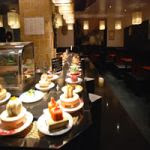That intoxicatin
 g perfume is a rare one in Europe and, honestly, even in America once you get to the coasts. It's certainly a scent I've never picked up in London until now.
g perfume is a rare one in Europe and, honestly, even in America once you get to the coasts. It's certainly a scent I've never picked up in London until now.Barbecoa is a joint venture between British celebrity chef Jamie Oliver and American BBQ guru Adam Perry Lang. The latter, much celebrated for bringing proper BBQ to New York City, has now gone trans-Atlantic and I'd guess the menu is mostly his. Pulled pork, baby back ribs, jalapeno cornbread, rubs, marinades, sauces, baked cheesecake. You could be anywhere in a meandering line from Texas through Memphis, St. Louis, Kansas City and Chicago. Look up from the menu though, and you're nowhere but London. And quite a posh bit of town at that. Barbecoa occupies a corner of the recently completed One New Change complex; its double-height glass walls looking straight onto the back of the newly cleaned St. Paul's cathedral. It's a stunning view and the designers have wisely decided not to compete with it, keeping the interiors modern, clean and understated.
The most interesting thing to look at here, once you get past the gorgeous view outside, is the massive kitchen around which the restaurant wraps. Food magazine-worthy displays of huge cuts of meat are almost as fascinating as the grills themselves ... vast tables of glowing coals with grills that can be raised or lowered by big metal wheels to get just the right temperature. (Should I ever win the lottery, I'm buying one of those.)
My meal mostly lived up to expectation. I started with the baby back ribs, which were just slightly overcooked and a bit too over-spiced, but certainly the best I've had in London. But the pulled pork was the stuff of final meal fantasies. Tender meat falling to shreds, slathered with a well balanced sauce, served in an American-sized mound beside the best jalapeno cornbread I've had since leaving Texas. Add some excellent slaw with the right combination of crunch, sweetness and tartness, and a pot of slow baked beans that had clearly been doctore
My companions didn't have quite the same experience, but then they didn't have smells and tastes triggering a lifetime of happy memories. The rib eye for two across the table was an exquisitely displayed fan of medium rare slices around a massive bone filled with rich marrow, which later gave our spaniel some intense hours of joy. Piers was probably least impressed, finding his pork belly to be just average in taste and rather small compared to the other main courses.
Had the service been better, Barbacoa would have vaulted instantly onto my Top 10 list. But here, sadly, the place leaves a lot to be desired. We had a table booked for 8:30. We arrived at 7:40 and settled into the bar, not expecting to be seated early but certainly thinking we'd get a decent table, on time. Instead, we finally sat down half an hour late in what's arguably one of the worst tables in the place, well away from both nice views (St. Paul's and the kitchen) and near the door. It then took a further 20 minutes to order. Starving, when told that starters would take 15 to 20 minutes, we opted for some bread. At £1 a slice this is a pricey extra, but it's served beautifully and features four distinctly different types. We would have enjoyed it more if it hadn't come at almost the same time as the starters, leaving us feeling that we'd wasted our money. Mains followed promptly, but then there was another long delay before being asked if we wanted dessert or coffee, taking orders (we only opted for the caffeine) and finally getting the bill. We didn't emerge until 11:30, meaning we didn't get home until 1am. Far too late for a school night, and well past expectations for an 8:30 table.
I have no doubt that I'll be back to Barbecoa. In fact, given that its front door is less than 200 yards from my London office, it will be hard to keep me away. But I'll be booking well in advance, for a table at 7:00.




